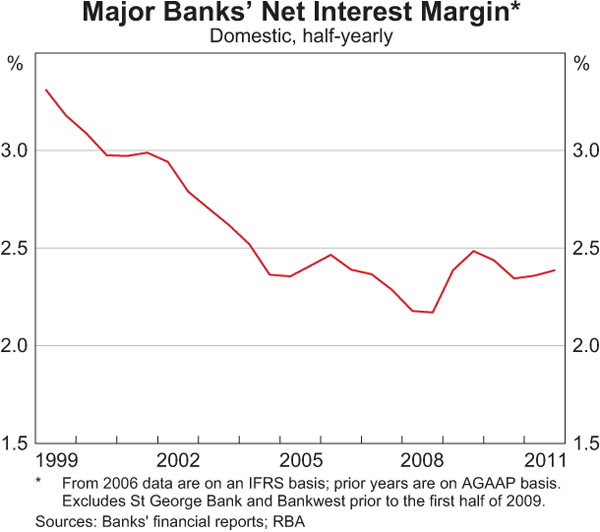Amidst the earnings season, National Australia Bank (NAB) provided the market with a quarterly trading update with a good headline result. But the devil is always in the detail and the macro picture.
First, the headline $1.4 billion in cash earnings was up 7% on the same period last year of $1.3 billion. Good news so far, but analysts expected in the order of $1.5 billion and all the metrics that I warned to watch for deterioration have indeed worsened:
- Net interest margin (NIM) fell to 2.19% from 2.28%
- Bad and doubtful debts increased to $545 million or 0.45% of gross loans compared to 0.35% of gross loans in second half of FY11
- 90+ days past due/impaired assets increased to 0.59% from 0.57% (from Sept to Dec 2011)
- Total debt provisions increased 3.3% to $5.1 billion
Net interest margin (NIM) measures the cost gap or margin between funding costs and revenue received on loans. Its not an exact measure, given the banks core model is to borrow funds at short term (e.g the latest wholesale funding maturity was less than 5 years on average) and lend at long term (nominally 30 year loans, but most “pay-off” the loan within 7 years, usually through refinancing or upgrading to a different property).
Even though bank profits have exploded in the last 15 years due to the unprecedented credit boom, their average NIM has reduced dramatically, hovering above the 2% mark since the GFC:

A UBS report this morning highlights that the slimming NIM, due to higher wholesale funding costs and the increased competition between the banks over deposits may actually reduce mortgage growth:
A report from UBS Securities says higher wholesale funding costs and intense competition to write home loans have left the banks facing a ‘dangerous situation’, with little incentive to offer mortgages.
They can re-price the interest rate on new mortgages above the official cash rate, they can hope for wholesale funding markets to improve, or they can stop writing mortgages.
We estimate the banks are currently losing money on new mortgages written in the current funding environment. Unless the banks re-price mortgages or funding markets improve significantly, there is no direct economic incentive for the banks to continue to write new housing loans … We see this as a dangerous situation for both the banks and the broader Australian economy.
With the Reserve Bank of Australia (RBA) meeting this afternoon, most likely to cut rates another 25 basis points (0.25%), it remains to be seen whether the banks will pass on any of this cut to its customers, as this vice tightens on profits and balance sheet asset quality (i.e the mortgage book and to a lesser extent, business loans).
Deutsche Bank contends that these first quarter “poor” results should not be extended into the latter half of the year:
We believe that 2H12 growth will be aided by the repricing of the mortgage book. We expect the banks to reduce the interest rates on the mortgage book by less than any official cash rate reductions.
The banks only need ~18bps to fully offset higher funding costs, however our forecasts assuming a ~3-4bps of margin decline in FY12, we really only need to see ~10 -12bps passed through and some repricing on business accounts.
This remains the biggest area of risk to our forecasts. For each 5bps of mortgage repricing that does not come through, this will take off ~1.3% of our earnings forecasts.
It’s not the current loan book that is facing pressure – but new loan creation, with wholesale funding and deposits costing most banks around 6% and introductory loans offered at 6.5 to 6.7% (standard rate at just over 7%).
That’s not a lot of meat left in the margin, even in a period of low, but steady credit growth.